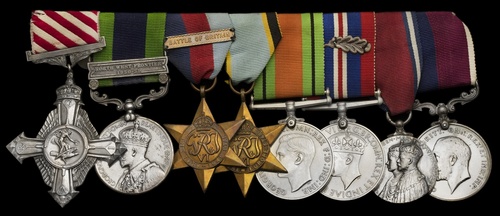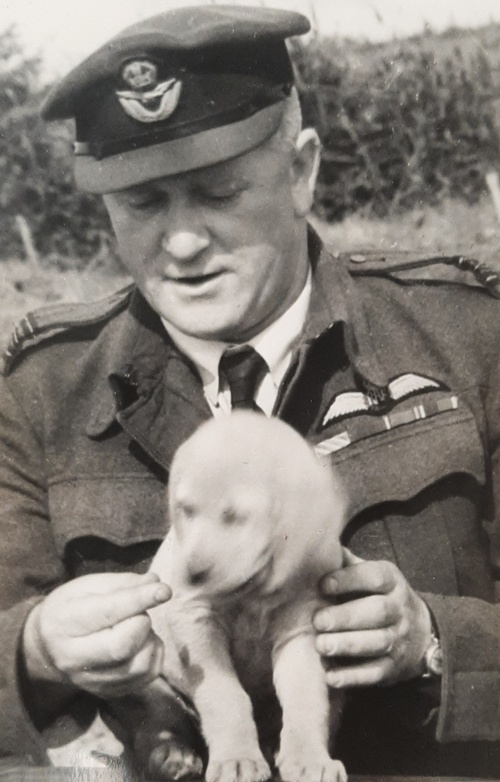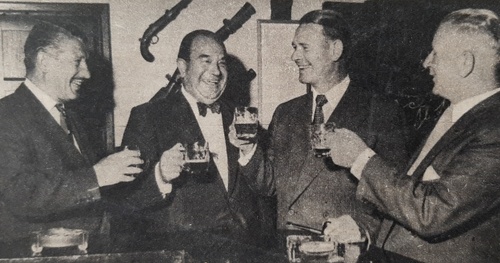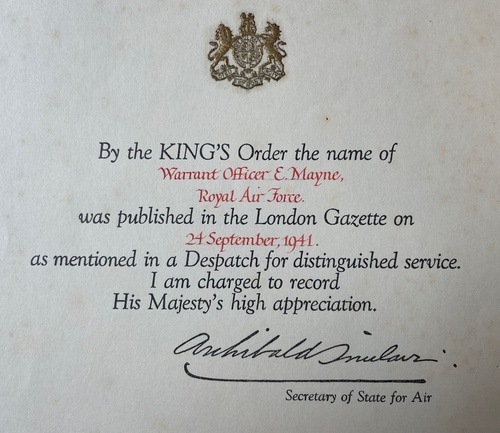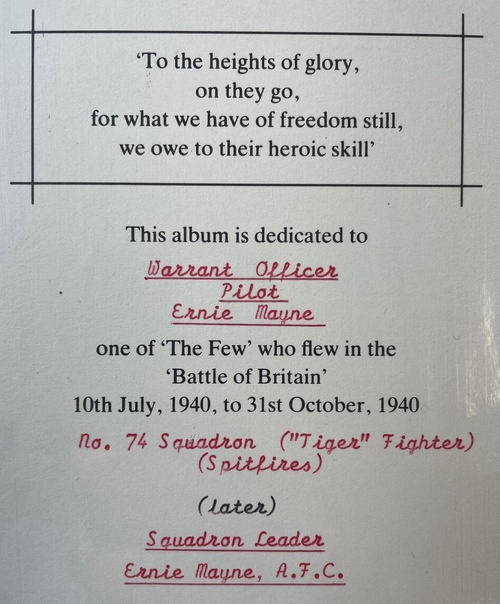Auction: 24003 - Orders, Decorations and Medals
Lot: 216
(x) 'One of the great-grandfathers of them all [The Few] was Tubby Mayne. He was thirty-nine and had the extraordinary distinction of having enlisted in the R.F.C. in the First World War and survived to fly a Spitfire in the Second; and many bewildered young pilots in 1940 were told: "If you follow that old ---- you won't go far wrong".'
The outstanding Second World War A.F.C. and Battle of Britain group of eight awarded to Squadron Leader E. 'Tubby' Mayne, Royal Air Force, late Royal Flying Corps, one of the oldest British fighter pilots to have flown with 'The Few'
Having seen action on the North-West Frontier in Wapitis of No. 11 Squadron in 1930, he graduated to Spitfires of No. 74 (Tiger) Squadron and quickly claimed a Me. 109 over Dunkirk in late May 1940, when he closed the range to 50 yards
Very much a squadron 'character' - who famously sported his old R.F.C. badge on his cap - Mayne flew regularly alongside 'Sailor' Malan in the Battle of Britain, up until his final sortie on 11 August 1940, when he claimed a Me. 109 and a Me. 110 as 'probables' and damaged others
Air Force Cross, G.VI.R., the reverse officially dated '1942'; India General Service 1908-35, 1 clasp, North West Frontier 1930-31 (82478 Sgt. E. Mayne, R.A.F.); 1939-45 Star, clasp, Battle of Britain; Air Crew Europe Star; Defence and War Medals 1939-45, with M.I.D. oak leaf; Jubilee 1935; Royal Air Force L.S. & G.C., G.V.R., coinage bust (82478 Sgt. E. Mayne, R.A.F.), mounted for wear, the earlier awards a little polished but generally very fine or better (8)
A.F.C. London Gazette 1 January 1942. The original recommendation states:
'Warrant Officer Mayne, prior to his posting to No. 56 O.T.U. in September 1939, did fine work in No. 74 Squadron destroying four enemy aircraft and assisting in the destruction of several others. He is an extremely able pilot with over 2500 hours flying experience. Warrant Officer Mayne has taken exceptional interest in his pupils, instilling great confidence into them and at all times setting an excellent example.'
Ernest Mayne was born in Newcastle on 2 January 1901 and was employed as a turner and fitter for Donkin & Co. in Walkergate, Northumberland on joining the Royal Flying Corps as boy entrant in May 1917 (Service No. 82478). He was subsequently attached to the R.N.A.S. Station at Grain on the Kentish coast but on account of his 'boy service' he was not awarded any campaign medals.
Advanced to Corporal in July 1922, he served on the strength of No. 70 Squadron in the Middle East in 1923-24, prior to being advanced to Sergeant and undertaking aircrew training in the summer of 1926. Duly qualified, he joined No. 11 Squadron in India, where he flew operationally in the unit's Wapitis in the summer of 1930, on reconnaissance and photographic sorties over Mohmand territory.
In August 1932, he removed to No. 23 Squadron at Hal Far, Malta, prior to returning to the U.K. and qualifying for his 'Wings' at Biggin Hill in March 1934, he was awarded the Jubilee Medal in the following year; the official roll, refers.
Dunkirk and the Battle of Britain
Subsequently posted to No. 74 'Tiger' Squadron at Hornchurch, he was likewise employed on the renewal of hostilities in September 1939.
Having then been advanced to Warrant Officer in May 1940, Mayne first saw action in the squadron's Spitfires over Dunkirk, when he joined an attack on an Hs. 126 on the 26th and claimed a Me. 109 on the 27th. Flying as Blue 3 on a patrol on the latter date, over the Dunkirk-Calis sector, Mayne was alerted by R./T. to an incoming stern attack by Me. 109s. His combat report takes up the story:
'…Suddenly I spotted a Me. 109 across my sights on the starboard side. I broke away and tried a 'snapshot' with a little deflection but was not satisfied, so closed to 50 yards and gave hima burst of approximately 400 rounds. By this time I was so close that I had to break away violently to avoid a collision. Blue 2 observed the engagement from above and confirmed the subsequent crash of the a/c.'
As evidenced by the squadron's Operational Record Book, regular patrols and sorties were undertaken back in the U.K. from early June. On 15 July, on departing one such patrol, Mayne left his famous R.F.C.-badged-cap at Manston. But instead of returning there he was diverted to Hornchurch and he never saw his cap again, a loss which is said to have deeply upset him.
Of his subsequent actions in the Battle of Britain, it was those fought on 11 August 1940 that proved the most memorable. On that date the 'Tigers' flew four separate sorties and claimed 24 victories and 14 damaged. For his own part, Mayne probably destroyed a Me.109 and a Me. 110 and damaged others. But as he later touched upon in his combat report for his fourth sortie of the day, he blacked out:
'I was Green 2, No. 74 Squadron on patrol at 24,000 feet over the Straits of Dover. Dysol Leader ['Sailor' Malan] gave the Tally-Ho and led the attack on E./A. below. The squadron in Line Astern dived steeply, first to the right and then to the left. I pulled my machine so sharply to the left that I blacked out. When I came around I was about 2,000 feet off Cape Griz Nez (sic). I found myself behind three Me. 109s and flying at about 1,000 feet closed in and opened fire on the No. 2 E./A. Blue smoke started to come from his engine. I closed in again and gave a fairly long burst. At this moment the No. 1 turned to the right and actually crossed my sights. He half rolled and went down. I did not see him crash, as my ammunition was running short, [and] I returned to base, but believed he must have done so.'
In a post-war interview for a Kentish newspaper, Mayne described the actions of the 11 August 1940 in greater detail:
'…Mayne's recollections are coloured, as many pilots' are, by affection and admiration for a leader. His leader was 'Sailor' Malan, by all accounts one of the greatest of all pilots. "If it wasn't for him, I wouldn't be sitting here. He always knew in that split second what to do." But it was following 'Sailor' that ended Mayne's own battle.
On August 11 [1940], when the squadron had only eight aircraft left, it intercepted a raid of 'fifty plus' over the North Foreland … "It was another of those damned perfect summer days, you remember them? There was the convoy going into the Thames - food and weapons and Heaven knows how much stuff we needed - and there were the bombers, you couldn't count them, I think it was the most we'd ever seen. I remember someone saying, 'Oh boy, oh boy'."
Mayne continues:
"It wasn't entirely a matter of numbers. As soon as you got stuck into them, the sky was full of aeroplanes, and they couldn't really tell how few of you there were. Anyhow, Sailor said 'Go through them,' so we did. Well, you know, after those tangles, you could never say exactly what had happened. One minute, it was aeroplanes everywhere. You picked one for yourself, and then another, if you were lucky, and then the next second it seemed the sky was empty, and you wondered where everyone had gone. But anyhow, the convoy was still there."
Mayne survived that fight and two more on the same day. It was the fourth, in the afternoon, that finished him for fighting. "It was silly the way it happened, but then a lot of people ended up in silly ways. We were over the French coast in line astern at 24,000 feet, and 'Sailor' saw something and made a tight turn, and I was on the tail end so I had to turn tighter still. And I blacked myself out and fell 20,000 feet before I came to … Then I couldn't remember where I was. But I saw three aeroplanes in formation, so I thought I'd join them, they'd take me home. Well, of course, they were Huns. I think that woke me up a bit. When I saw the crosses I had a shot at one, but then I thought, this is no place for you, you'd better be off. So I did."
Mayne found his way home.
"But falling hadn't done my ears any good. They felt as if they were standing out like balloons. So I finished up in hospital, and that was that. It was silly to black out to that extent, but I think it was partly tiredness and, let's face it, old age. At thirty-nine your heart and arteries weren't really up to it."'
For their gallant efforts on 11 August 1940, 74 'Tiger' Squadron received the following message from Sir Cyril Newall, the Chief of Air Staff:
'A magnificent day's fighting, No. 74 … this is the way to keep the measure of the Boches. [Mick] Mannock started it and you keep it up!"
On being stood down from operations, Mayne was engaged in ferrying Spitfires around the Hornchurch, Wittering and Kirton in-Lindsey sectors.
Then in mid-September 1940 he was posted away to No. 6 O.T.U. at Sutton Bridge, where he commenced his career as a flying instructor. Subsequently commissioned, he was mentioned in despatches (London Gazette 24 September 1941, refers) and awarded the A.F.C. in January 1942, and ended the war as a Station Gunnery Officer at Manston.
Placed on the Retired List in December 1945, Mayne - who was permitted to retain the rank of Squadron Leader - settled in Thanet, Kent, where he died in March 1978.
Sold with the recipient's original privately bound Flying Log Book, with gilt inscription 'F./Sgt. E. Mayne' and covering the period July 1926 to October 1936, when he joined No. 74 'Tiger' Squadron at Hornchurch; together with his M.I.D. certificate, in the name of 'Warrant Officer E. Mayne, Royal Air Force' and dated 24 September 1941; personalised presentation album for 'The Few', as assembled by Flight Lieutenant J. H. Holloway, M.B.E., and sent to veterans of the Battle in the 1960s; Programme for Westminster Abbey Service of Thanksgiving for the Battle of Britain, 21 September 1969 and a selection of newspaper cuttings.
Subject to 5% tax on Hammer Price in addition to 20% VAT on Buyer’s Premium.
Sold for
£18,000
Starting price
£7000

